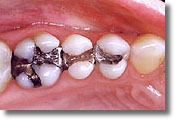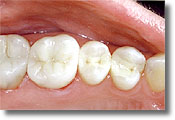This page provides information about the pros and cons of white composite fillings versus silver amalgam fillings. There are several important differences between the two types, it’s not just a matter of appearance.
As a patient, your dentist should inform you of the availability of the white composite fillings. If you have had amalgam fillings placed in your mouth without being offered the option of having white fillings instead, the dentist has not performed his or her legal duty.
Given the opportunity to make a fully informed choice, my experience is that the vast majority of today’s dental patients will choose the white fillings. There are several reasons for this: In the view of many, the mercury in amalgam is viewed as potentially toxic. (Traditional dentists like to use the term “silver fillings,” but this is kind of a euphemism. They actually have more mercury in them than silver.) Also, the feeling is that the white composite represents a more advanced technology. Additionally, composite is more esthetic. For all these reasons, the public is demanding white. And, with today’s technology, composite fillings can easily withstand the stress required to serve in a back tooth.


Further information about white fillings:
- Information about the cost of white fillings.
- A patient’s bad experience with pain after getting white fillings.
ADVANTAGES OF WHITE FILLINGS:
- Since they bond to the tooth, composite fillings restore most of the original strength of the tooth. Silver weakens the teeth, making them more susceptible to breaking. Since broken teeth are very expensive to restore, composites can save a lot of expense over the long run.
- Composite fillings restore the natural appearance of the tooth.
- Teeth restored with white fillings are less sensitive to hot and cold than teeth restored with amalgam, if correct techniques are used.
- Composites are mercury-free. Mercury in the fillings is viewed by some as being toxic.
- Composites require less removal of tooth structure. Especially with new cavities, the size of the hole made for the filling can be dramatically smaller with composites. Click here to view photographs showing tooth preparations for white fillings as compared to tooth preparations for amalgam fillings, and see for yourself the differences in the amount of tooth a dentist has to drill away.
ADVANTAGES OF SILVER AMALGAM FILLINGS:
- They are generally less expensive. Composite fillings, if they are done correctly, take about 60% longer, require special expertise and expensive materials, and are more difficult to place, and so they cost considerably more than silver. Dental insurance companies may not pick up this extra cost. Click here for extra information about the costs of white fillings.
- General dentists can place amalgam without extra training. Composite requires the use of special bonding technology that many dentists are uncomfortable with.
- The proper placement of a white filling requires that the site for the filling be kept totally isolated from saliva while it is being placed. In the very back of the mouth, on some patients, it is difficult to keep the tooth isolated for the duration of the procedure. This can also be uncomfortable for some patients. A silver amalgam filling does not require this strict isolation of the tooth.
- The filling by itself is a stronger material, although it weakens the tooth.
- Amalgam fillings have a longer history of use than mercury-free fillings, thus some feel that they are more tried and tested.
One caution—the composite fillings can be seriously weakened by excessive alcohol consumption. If you have a habit of drinking beverages with high alcohol content (whiskey, etc.) on a daily basis, you may find the composite fillings deteriorating prematurely.
Dental schools have only recently been training dentists for placing these newer types of fillings. So older dentists will have to have pursued additional post-graduate continuing education to become proficient in composite bonding technology. For a directory of dentists trained to provide these services, please see our cosmetic dentist referral page.
More information:
Click here to read frequently asked questions about composite fillings and amalgams.
Read Dr. Hall’s blog posts about white fillings, where he answers questions from visitors.
This content was written by Dr. David Hall. Click here to ask Dr. Hall a question.
